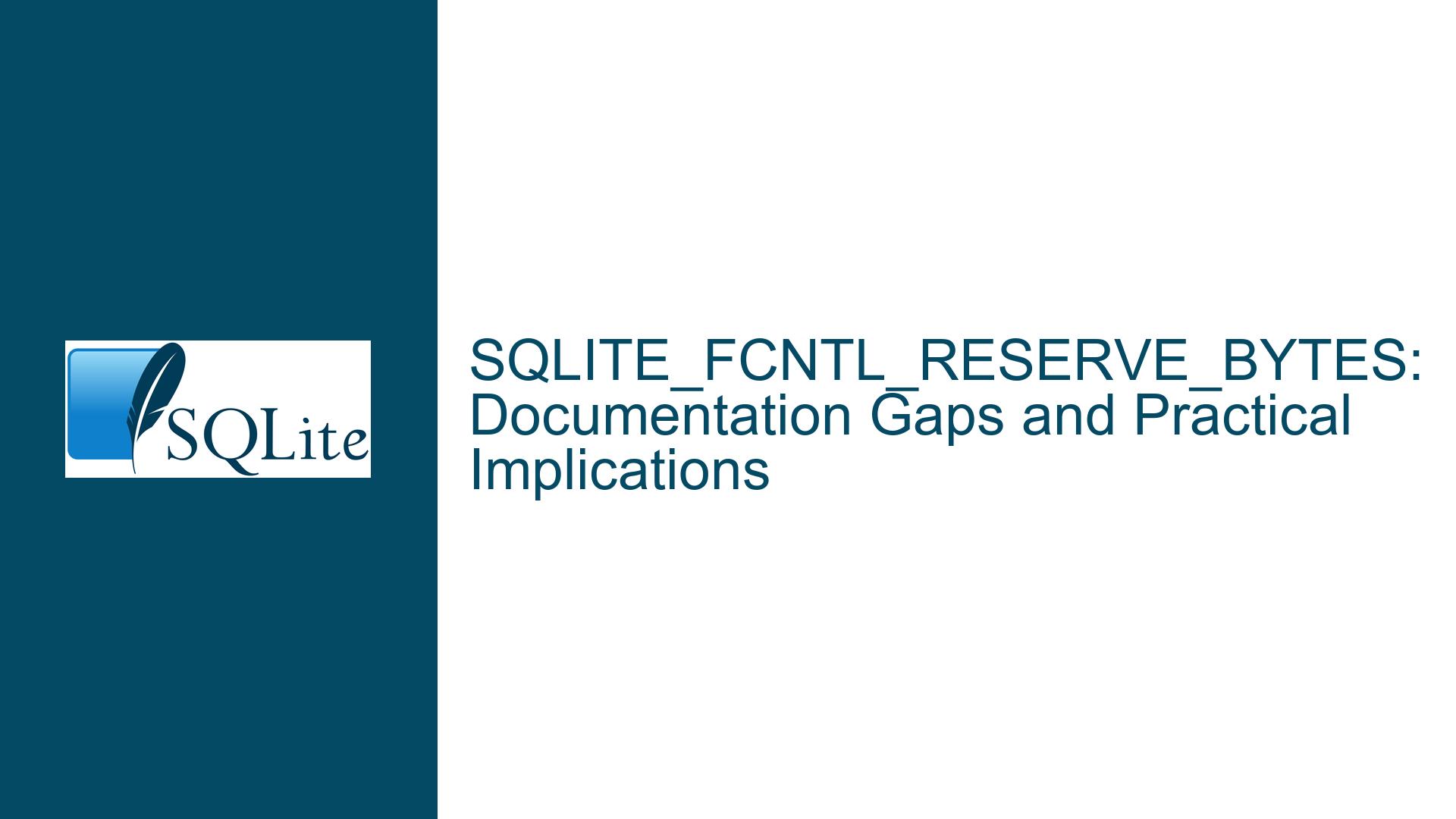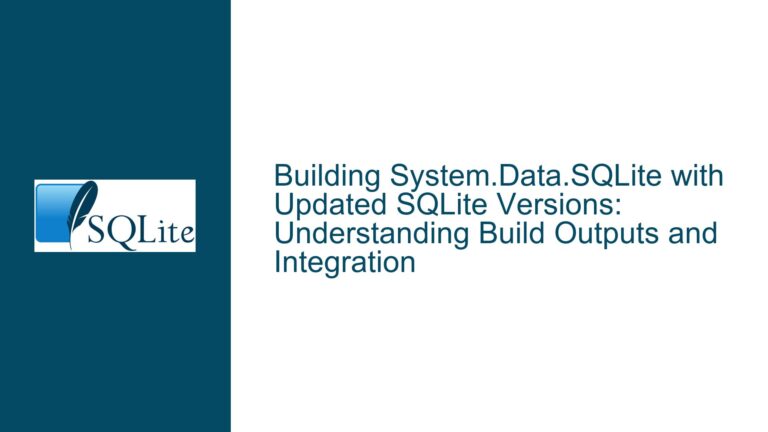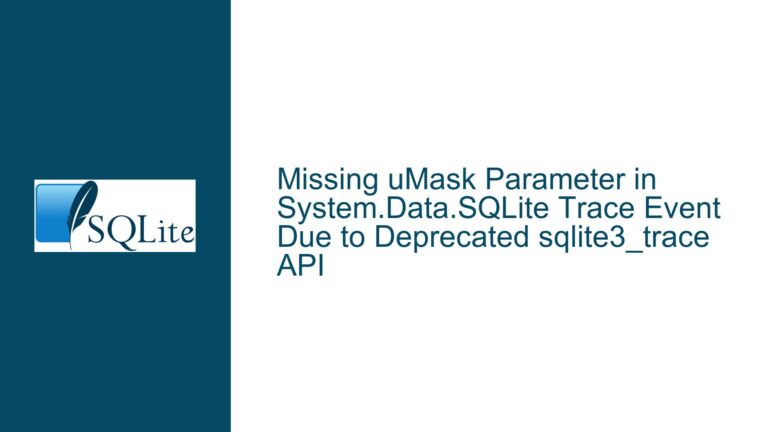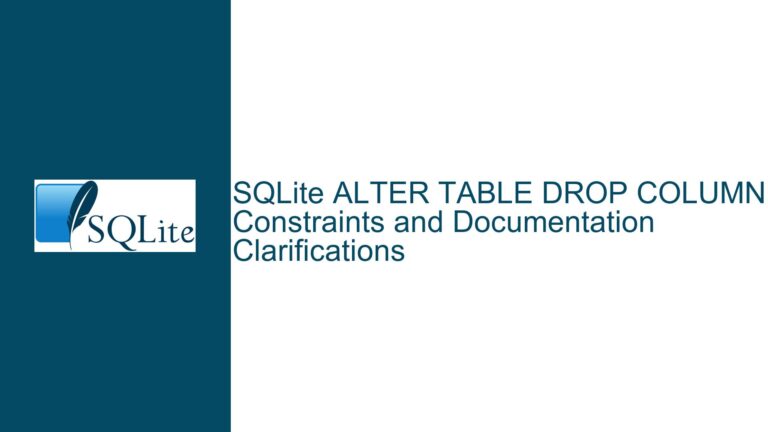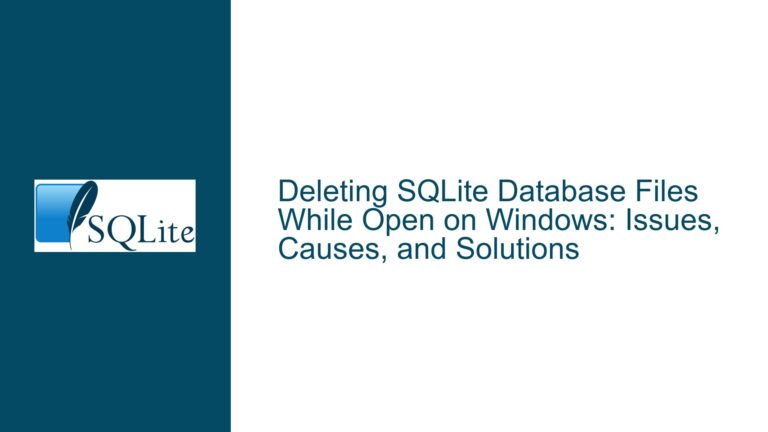SQLITE_FCNTL_RESERVE_BYTES: Documentation Gaps and Practical Implications
SQLITE_FCNTL_RESERVE_BYTES: Undocumented Behavior and Its Impact on Database Operations
The SQLITE_FCNTL_RESERVE_BYTES file control is a critical yet underdocumented feature in SQLite that allows applications to reserve a specific number of bytes at the beginning of the database file. This reservation is particularly useful for custom Virtual File System (VFS) implementations, such as those involving checksum calculations or compressed databases. However, the lack of comprehensive documentation has led to confusion and potential misuse of this feature. The primary issue lies in the fact that SQLITE_FCNTL_RESERVE_BYTES is only briefly mentioned in the list of file control constants and incorrectly referenced in the checksum VFS shim documentation. This gap in documentation has significant implications for developers who rely on this feature for advanced database operations.
The SQLITE_FCNTL_RESERVE_BYTES file control is not automatically set by the VFS; it must be explicitly configured by the application. This requirement introduces a layer of complexity, as developers must manually manage the reserved bytes and ensure compatibility with their custom VFS implementations. Furthermore, the use of synthetic database headers to specify reserved bytes is a workaround that, while functional, is not ideal. Synthetic headers can override default database configurations, leading to unintended consequences if not handled carefully. This issue is particularly relevant for developers working with read-only compressed databases or other specialized VFS implementations.
The lack of clear documentation also raises questions about the intended use cases and limitations of SQLITE_FCNTL_RESERVE_BYTES. For instance, it is unclear whether the reserved bytes are preserved across database operations or if they are only applicable during specific phases of database access. Additionally, the interaction between SQLITE_FCNTL_RESERVE_BYTES and other file controls is not well-explored, leaving developers to rely on trial and error when integrating this feature into their applications. This ambiguity can lead to suboptimal implementations and potential database corruption if the reserved bytes are not managed correctly.
Interrupted Write Operations and Synthetic Database Headers: Key Causes of Misconfiguration
One of the primary causes of issues related to SQLITE_FCNTL_RESERVE_BYTES is the improper handling of interrupted write operations. When a database operation is interrupted, such as during a power failure or system crash, the reserved bytes may not be written correctly, leading to database corruption. This is particularly problematic for applications that rely on custom VFS implementations, as the reserved bytes are often used to store critical metadata or checksums. If these bytes are corrupted, the entire database may become inaccessible or unusable.
Another significant cause of misconfiguration is the use of synthetic database headers to specify reserved bytes. While this approach can be useful for certain applications, such as read-only compressed databases, it introduces several challenges. Synthetic headers override the default database configuration, which can lead to inconsistencies if not managed properly. For example, if a synthetic header specifies a reserved byte value that conflicts with the application’s requirements, the database may fail to load or operate correctly. Additionally, synthetic headers cannot be overridden once they are set, limiting the flexibility of the application.
The reliance on synthetic headers also complicates the process of managing reserved bytes. Developers must ensure that the synthetic header is correctly generated and applied, which can be error-prone and time-consuming. This is especially true for applications that require dynamic configuration of reserved bytes, as the synthetic header must be regenerated each time the configuration changes. This process can introduce additional overhead and increase the risk of errors, particularly in high-availability or high-performance environments.
Implementing PRAGMA journal_mode and Database Backup: Best Practices for Managing Reserved Bytes
To address the challenges associated with SQLITE_FCNTL_RESERVE_BYTES, developers should adopt a comprehensive approach that includes proper configuration, robust error handling, and regular database backups. One of the most effective strategies is to use the PRAGMA journal_mode command to configure the database journaling mode. The journaling mode determines how SQLite handles transactions and ensures data integrity in the event of an interruption. By setting the journaling mode to WAL (Write-Ahead Logging), developers can improve the reliability of their database operations and reduce the risk of corruption.
In addition to configuring the journaling mode, developers should implement a robust backup strategy to protect against data loss. Regular database backups can help mitigate the impact of interrupted write operations and ensure that the reserved bytes are preserved. SQLite provides several tools for creating and managing backups, including the sqlite3_backup API and the .backup command in the SQLite shell. These tools allow developers to create consistent backups of their databases, even while the database is in use.
Another best practice is to carefully manage the use of synthetic database headers. While synthetic headers can be useful for certain applications, they should be used sparingly and with caution. Developers should ensure that the synthetic header is correctly generated and applied, and that it does not conflict with the application’s requirements. Additionally, developers should consider using alternative approaches, such as custom VFS implementations, to manage reserved bytes without relying on synthetic headers.
Finally, developers should thoroughly test their database configurations to ensure that the reserved bytes are correctly managed and that the database operates as expected. This includes testing for edge cases, such as interrupted write operations and system crashes, to ensure that the database can recover gracefully. By adopting these best practices, developers can minimize the risks associated with SQLITE_FCNTL_RESERVE_BYTES and ensure the reliability and integrity of their databases.
Detailed Analysis of SQLITE_FCNTL_RESERVE_BYTES and Its Implications
The SQLITE_FCNTL_RESERVE_BYTES file control is a powerful feature that allows applications to reserve a specific number of bytes at the beginning of the database file. This feature is particularly useful for custom VFS implementations, such as those involving checksum calculations or compressed databases. However, the lack of comprehensive documentation has led to confusion and potential misuse of this feature. This section provides a detailed analysis of SQLITE_FCNTL_RESERVE_BYTES and its implications for database operations.
Understanding SQLITE_FCNTL_RESERVE_BYTES
The SQLITE_FCNTL_RESERVE_BYTES file control is used to reserve a specific number of bytes at the beginning of the database file. These reserved bytes can be used for various purposes, such as storing metadata, checksums, or other application-specific data. The reserved bytes are not used by SQLite itself, but are instead available for use by the application or custom VFS implementation.
The SQLITE_FCNTL_RESERVE_BYTES file control must be set by the application; it is not automatically set by the VFS. This means that developers must explicitly configure the reserved bytes and ensure that they are correctly managed throughout the lifecycle of the database. This requirement introduces a layer of complexity, as developers must carefully manage the reserved bytes and ensure compatibility with their custom VFS implementations.
Implications for Database Operations
The use of SQLITE_FCNTL_RESERVE_BYTES has several implications for database operations. One of the most significant implications is the potential for database corruption if the reserved bytes are not managed correctly. For example, if a database operation is interrupted, such as during a power failure or system crash, the reserved bytes may not be written correctly, leading to database corruption. This is particularly problematic for applications that rely on custom VFS implementations, as the reserved bytes are often used to store critical metadata or checksums.
Another implication is the use of synthetic database headers to specify reserved bytes. While this approach can be useful for certain applications, such as read-only compressed databases, it introduces several challenges. Synthetic headers override the default database configuration, which can lead to inconsistencies if not managed properly. For example, if a synthetic header specifies a reserved byte value that conflicts with the application’s requirements, the database may fail to load or operate correctly. Additionally, synthetic headers cannot be overridden once they are set, limiting the flexibility of the application.
Best Practices for Managing Reserved Bytes
To address the challenges associated with SQLITE_FCNTL_RESERVE_BYTES, developers should adopt a comprehensive approach that includes proper configuration, robust error handling, and regular database backups. One of the most effective strategies is to use the PRAGMA journal_mode command to configure the database journaling mode. The journaling mode determines how SQLite handles transactions and ensures data integrity in the event of an interruption. By setting the journaling mode to WAL (Write-Ahead Logging), developers can improve the reliability of their database operations and reduce the risk of corruption.
In addition to configuring the journaling mode, developers should implement a robust backup strategy to protect against data loss. Regular database backups can help mitigate the impact of interrupted write operations and ensure that the reserved bytes are preserved. SQLite provides several tools for creating and managing backups, including the sqlite3_backup API and the .backup command in the SQLite shell. These tools allow developers to create consistent backups of their databases, even while the database is in use.
Another best practice is to carefully manage the use of synthetic database headers. While synthetic headers can be useful for certain applications, they should be used sparingly and with caution. Developers should ensure that the synthetic header is correctly generated and applied, and that it does not conflict with the application’s requirements. Additionally, developers should consider using alternative approaches, such as custom VFS implementations, to manage reserved bytes without relying on synthetic headers.
Finally, developers should thoroughly test their database configurations to ensure that the reserved bytes are correctly managed and that the database operates as expected. This includes testing for edge cases, such as interrupted write operations and system crashes, to ensure that the database can recover gracefully. By adopting these best practices, developers can minimize the risks associated with SQLITE_FCNTL_RESERVE_BYTES and ensure the reliability and integrity of their databases.
Conclusion
The SQLITE_FCNTL_RESERVE_BYTES file control is a powerful yet underdocumented feature in SQLite that allows applications to reserve a specific number of bytes at the beginning of the database file. While this feature is useful for custom VFS implementations, the lack of comprehensive documentation has led to confusion and potential misuse. By understanding the implications of SQLITE_FCNTL_RESERVE_BYTES and adopting best practices for managing reserved bytes, developers can minimize the risks associated with this feature and ensure the reliability and integrity of their databases.
